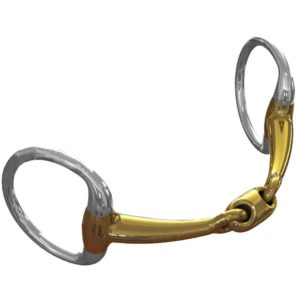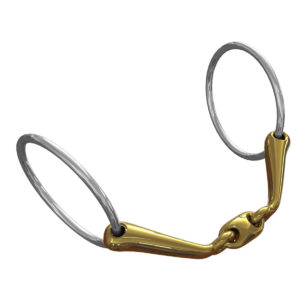Giving a young horse the right start to its training is essential to finding its true potential and making sure you are using the right bit is a major factor in doing this. The support offered by using the right bit for a young horse is essential when starting to build the foundations of the horse’s training that he will need throughout his career.
Riders are realising the horse’s bit is equally important piece of tack.
When finding a bit for a young horse it is also important to consider the size of the mouthpiece. For young horses, Heather recommends mouthpieces with a good weight bearing surface which then doesn’t target a specific area; around 16mm thickness is idea. Heather suggests “A baby might trip or lack balance, or he could be very spooky, but you don’t want them to punish themselves if they take a fright or trip, so you do need a slightly thicker bit.”
Issues that would be a challenge with mature horses are exaggerated with babies and they need to be carefully handling and training in order to prevent it from becoming a lifelong issue. Youngsters can be headstrong and if they don’t understand the aids they are likely to run on. Simply increasing the strength of the bit that you use may cause further problems. Heather says “If you put a stronger bit on a horse who runs off when confused or scared it could be disastrous as it is a trust issue, you do need collection and control but if the first thing that kicks in is a strong bit they’ll panic and try and run through it and this could really set them back in their training.”
To solve this problem, Heather suggests finding a bit that works on different pressure points collectively in order to give you better control, “The basis of a bit for control is to save the mouth, so you don’t have to haul on the reins, once a horse has experimented with a bit he’ll work within those parameters.” Failure to maintain a contact or being tentative in the contact is another common problem with younger horses. Heather suggests trying a fixed cheek bit to offer stability, which will help him to reach for a contact more. She says “It’s not often a comfort thing but a confidence thing, the fixed cheek will encourage him to experiment a bit more and start taking the rein forward and down.”
If you are still struggling to maintain a contact make sure to check there is nothing that could be causing the horse to be reluctant to take a contact – for example wolf teeth. If your horse tends to become over bent or fixates on the bit rather than listening to your signals, Heather recommends trying a bit with loose rings, such as a loose ring snaffle bit, which allows for gentler mouthing.
When introducing a new bit to your horse it is always important to do so carefully and to always be patient. Heather suggests “Test any new bit methodically in a calm situation like your school. Don’t jump straight in and go flat out. Work in walk and trot at first and work slowly up to what you are aiming to do.”
Make sure your other tack is consistent so you can be sure any difference in his way of going is down to the bit alone.
Working on the lunge can help a horse get to grips with a new bit as it is easier for him to take his neck forward and down without having to think of the weight of the rider as well. If a horse has low confidence or if the rider is struggling with contact, Heather recommends side reins as they will help a horse to stretch and take the contact forward and down. “They shouldn’t be tight or restricting his neck, but should offer enough support for the horse to feel secure and confident. By doing this correctly you are introducing a horse to a new bit in a way that is easier for them to accept it.
Regularly switching a horse’s bit between several that are comfortable and effective is now viewed as a positive step in the horse’s training and development. Heather explains that applying the same pressure day-in, day-out will cause a horse to build up resistance towards that bit, but by changing the bit you will employ different pressure points and keep things fresh.
“Horses can get very tense under unfamiliar demand and can revert to old habits or an incorrect ways of going, so if you know the penny won’t drop for a while use a familiar bit to support him and give him confidence.” However, you must ensure that your youngster understands all you’ve taught him before you move on, or you risk confusing him and setting your progress back. Heather says “There’s no substitute for basic training. If a horse doesn’t understand the signals through the rein and the rider doesn’t know how to apply them, there isn’t a bit in the world that can change that.”

